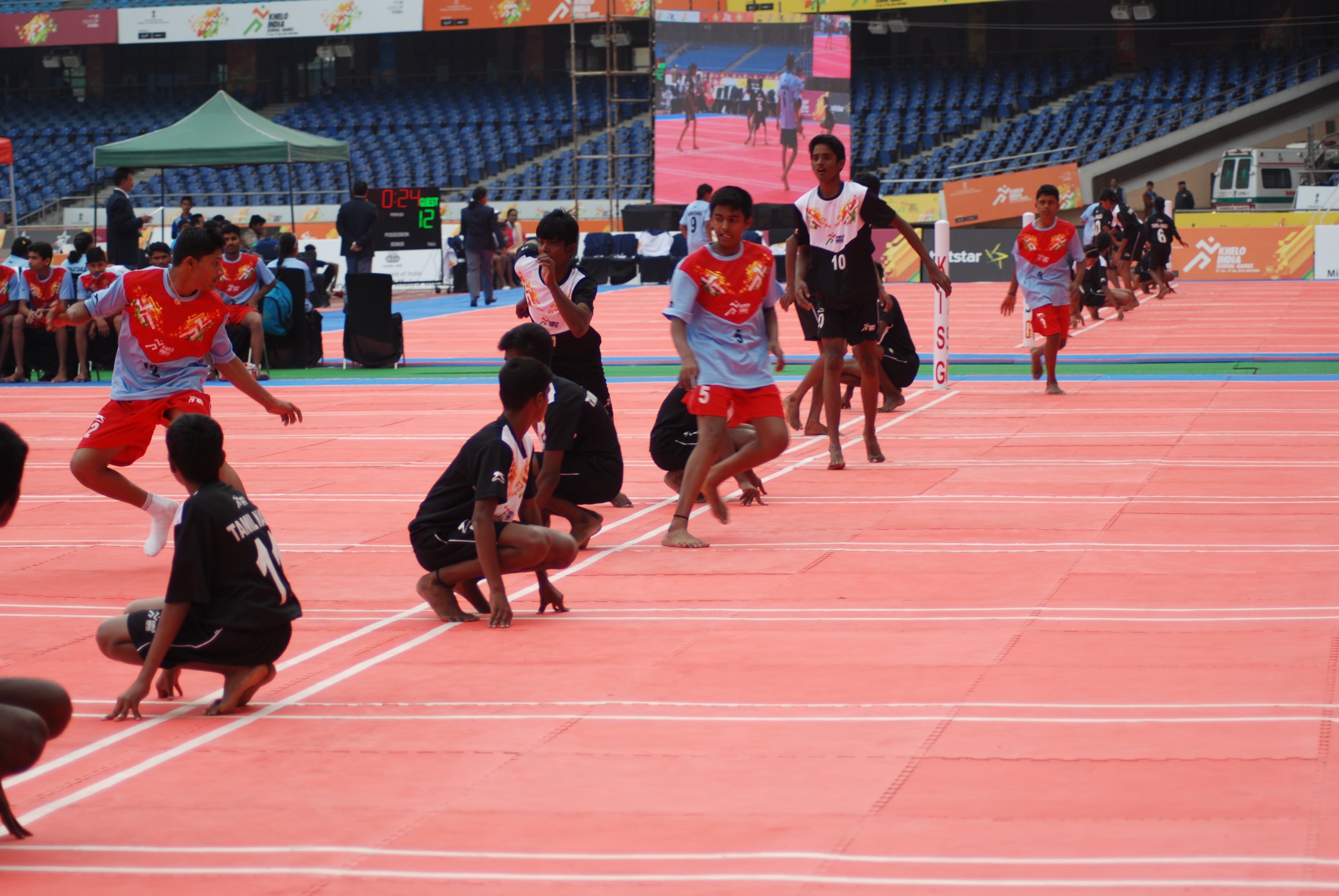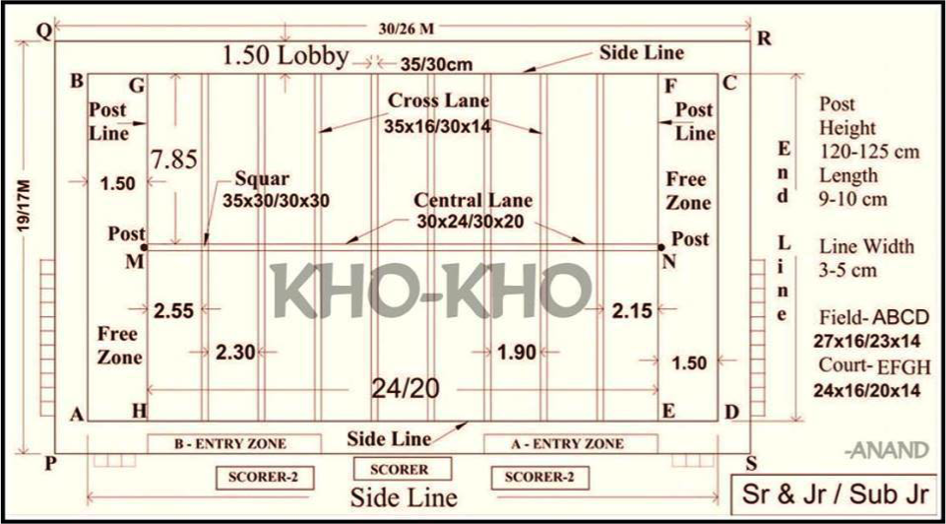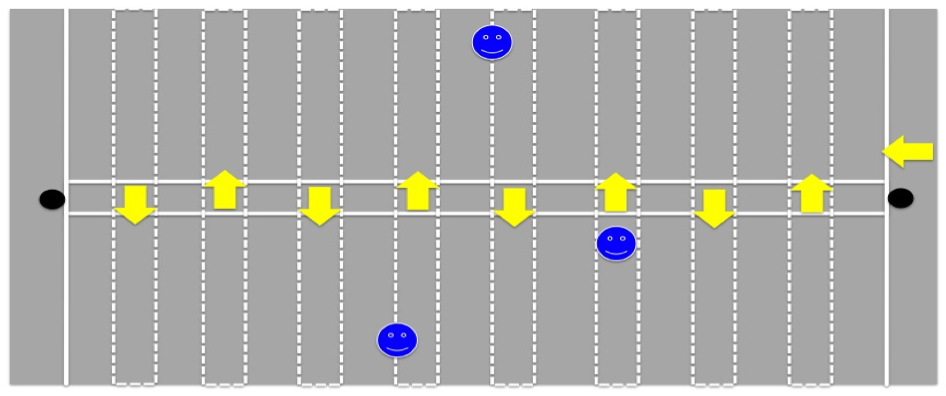
Kho Kho (India)
- Name of sport (game): Kho Kho
- Name in native language: Punjabi: ਖੋ-ਖੋ
- Place of practice (continent, state, nation):
India, Bangladesh, Pakistan, Sri Lanka, Nepal, Maldives, Japan, South Africa
- History:
Kho Kho is a traditional sport from the Indian subcontinent. This sport appeared long ago in Pune Gymkhana the state Maharashtra. Together with kabbadi, it’s one of the two most popular traditional sports in South Asia.
It was played on chariots called Rath. In its ancient form, the game was known as Rathera.
It was a very popular sport, and for many years practiced in an informal way. In order to popularize the game club, Deccan Gymkhana from Pune tried to formalize its rules.
The present appearance of the game was an adoption about the time of World War I in 1914. But at that time, there were neither any dimensions of the playground nor the poles which demarcate the central lane.Kho Kho is a tag game, it could also be called Game of hunting. Kho Kho is a traditional game played in India. Its origins are ancient, with strategies and tactics likely derived from the epic ‘Mahabharata’. On the 13th day of the war, the Kaurava General Guru Dronacharya created the ‘Chakravyuha’ a special military defensive circle which was eventually penetrated by the renowned warrior Abhimanyu. He was killed eventually by having to fight alone against 7 other warriors but he inflicted heavy casualties in return. His style of fighting reflects the concept of ‘ring play’ – a defensive tactic in Kho Kho. There are many other similarities. It has gradually become a favorite game of children and for many centuries served as entertainment.
Deccan Gymkhana Pune, a club created by the Indian leader Lokmanya Tilak, formalized the rules of the game for the first time. This initial stage marked the limitation of the playground and yet sadly lacked the poles demarking the central lane in the field. Instead, less experienced players were posted squatting at the ends of the latter and chasers ran around them to return to the midfield. In 1919, the Kho Kho game area was limited to 44 yards of the central lane length and 17 yards of the ellipse width.
The years 1923-24 saw the foundation of the Inter School Sports Organization and Kho Kho was introduced to develop at the grassroots and consequently popularize the sport.
Those efforts can be compared to those of Deccan Gymkhana and Hind Vijay Gmykhan. Other popular games like Langdi and Atya-Patya, allowed to practice similar skills as Kho Kho. Especially the latter game requires special mention, because it was well known, and important for Kho Kho, because it developed defense skills.Akhil Maharashtra Sharirik Shikshan Mandal (Institute of Physical Education) was founded in 1928 when Dr. Abasahib Natu Pune, Mahabal Guruji from Nasik, Karmarkar Vaidya from Miraj and Dr. Mirajkar Bombaju, in cooperation with Kho-Kho experts, formulated the rules and regulations of the game, which differed somewhat from the Federation regulations of nowadays.
Hind Vijay Gymkhana, Baroda and Deccan Gymkhana, Pune had their own rules that differed too. In 1933, experts from around sixty Gymkhanas gathered and developed a code of principles called Akhil Maharashtra Sharirik Shikshan Mandal which was acknowledged in 1935.
Over the years the rules have changed. Firstly, in 1914, 10 points were scored for each opponent and the round lasted nine minutes. In 1919, the score was reduced to 5 and the match lasted eight minutes. In the following years, points were also given as an early ending bonus. Further changes concerned the playing field, which was changed into a rectangle instead of an ellipse. The distance between the two ends was shortened to 27 yards, a free zone was created beyond the ends of the game rectangle 27 yards x 5 yards, also known as zone "D". In this zone, the hunter could move in any direction, regardless of the direction change.
Kho Kho was first presented in Berlin during the Olympic Games in 1936. The first national championship of India Kho-Kho was played in Vijay Wada, in the state of Andhra Pradesh, in 1959/60 under the auspices of the Federation of India Kho-Kho. The team lead from Bombay area won the competition. Rajabhau Jeste who led it was a champion of this game, an expert and commentator. First women’s championships were held in 1960/61.
In 1982, Kho-Kho was incorporated into the Indian Olympic Association and a few years later, in 1989 a show was held during the 'Asian Games' Festival. At that time, several changes were made to the game, accepted and included by the Asian Federation. The pillars were moved to a distance of 23.50 meters, and the square of the game was increased in width to 16 meters. The duration of the rounds was set at nine minutes.
First International Championships were organized in Kolkata in 1982.Kho-Kho can develop many desirable traits – sports competition, teamwork, loyalty, self-confidence, speed, agility, strategical thinking. Kho Kho is not only a sport with a lot of running and crouching, but it's also a great school of teamwork. Players must watch each other closely, cooperate, recognize situations and take decisions quickly. This sport has also a strategic dimension. Not only it shapes the body but also sharpens the mind
- Description:
Kho Kho is played by teams of 12 nominated players out of fifteen, of which nine enter the field who sit on their knees (chasing team), and 3 extra (defending team) who try to avoid being touched by members of the opposing team.

One team sits on their knees in the middle of the court, 8 in a row, with adjacent members facing opposite directions. One team sits or kneels in a row in the center of the field. The runners of play in the field, three at a time and the team that takes the shortest time to touch all the opponents in the field wins.The Kho Kho is played on a rectangular field, 30 meters long and 19 meters wide ( according to other sources: 27 meters long and 15 meters wide). There are two rectangles at the end. The length of this rectangle is 16 m and width is 2.75 (2.7 m). In the middle of these two rectangles, there are two wooden poles. The central path is 23.5 (21.60) long and 30 cm wide. There are eight transversal strips that lie across the central belt, their length is 16 (15) meters and width 30 cm. This makes small rectangles, each of them 16 meters long and 2.3 meters wide (two rectangles near wooden posts are 2.5 meters wide), which are perpendicular to the middle belt and evenly divided into two parts of 7, 85 (7.3) meters each. At the ends of the central path, there are two wooden posts, 120 cm high, permanently located. Their perimeter is between 30 and 40 cm. They are made of wood, smooth along the entire length, flat in the
upper part.
- Current status:
Sport practiced
Federation of India Kho-Kho (K.K.F.I.) is the most important association for this sport. It has branches in many countries and conducts Mini, Junior and open Championships for both genders in many parts of India.
The Kho-Kho Federation of India was founded in 1956 with modern game rules under the leadership of Lt. Bhai NERURKAR Maharashtra, Lt. Bhupati Mazumder, Lt. Sambhunath Mallik and Lt. Deben Bose West Bengal.
In 1959-60, the first Kho-Kho championship was organized in Vijayawada (Andhra Pradesh). Prizes were founded on the initiative of the government: Arjuna Award, Eklavya - men's prize, Rani Laxmi Bai - for women, Veer Abhimanyu - for boys under 18 years old and the Janaki award for girls under 16 years of age.In 1960, the Federation of India Kho-Kho began to promote the sport in schools, universities and clubs. In the same year, the first national competition Kho Kho was organized only for men in Vijayawada. Three teams participated. In 1961, a national competition for women was organized, in which four teams participated.
In 1963-64, to award best players Kho Kho, the Federation of India introduced a prize for the best player - EKALABYA for men and RANI JHANSI for women. The Kho Kho Federation began to organize the Junior National Championship for boys in 1970 and for girls in 1972. In order to encourage young people, an award for the best junior was founded - ABHIMANYU VEER for boys and JANAKI for girls. In 1980, the Junior category was introduced for boys and girls. BHARAT award for boys and ILA for girls were established.
As part of the Sports Authority of India, six-week training courses were introduced as part of this discipline. In 1977, the duration of the course was increased to 10 months. Since Kho Kho & Kabadi were connected, it was difficult to complete the Kho Kho course within 10 months. In 2008, a separate 10-month training course for Kho Kho trainers was established. In 1985, Kho Kho was included in the first National Competition held in Delhi, thanks to the personal efforts of Sri Ashok Ghosh, the President of the Bengal Olympic Association.
The Asian Kho Kho Federation was founded in 1987 during the third SAF Games competition in Calcutta, India. The Federation includes India, Bangladesh, Pakistan, Sri Lanka, Nepal and Maldives. The first Asian Championships took place in Calcutta in 1996 and the second in Dhaka in Bangladesh. The participants of the championships were India, Sri Lanka, Pakistan, Nepal, Japan, Thailand and Bangladesh.
- Contacts:
Kho Kho Federation of India - http://khokhofederation.in/
Kho Kho Federation of England: KKFE - http://khokho.co.uk/
Madhya Bharat KHO KHO - https://www.facebook.com/Madhya-Bharat-KHO-KHO-807347155952035/
KHO KHO Andhrapradesh - https://www.facebook.com/INDIANSPORTKHOKHO/?fref=pb&hc_location=profile_browser
Kho-Kho Clics - https://www.facebook.com/Kho-Kho-Clicks-679707098807875/?fref=pb&hc_location=profile_browser
KHO-KHO TEAM FROM TAMIL NADU - https://www.facebook.com/khokho.svm/
Kho Kho Federation of England - https://www.facebook.com/kho.england/
- Sources of information :
Video:
https://www.youtube.com/watch?v=kD-D6QWDn7k
2016 - South Asian Games - Kho-kho - Men's Group Match - India vs Nepal - https://www.youtube.com/watch?v=UodKkoktvUs
Senior kho kho national (baramati) kolhapur v/s maharashtra - https://www.youtube.com/watch?v=csSPTMImb6g
49th National Kho Kho Championship, Solapur - https://www.facebook.com/49th-National-Kho-Kho-Championship-2015-Solapur-1677540765814919/?fref=pb&hc_location=profile_browser - Gallery:
- Documents:

